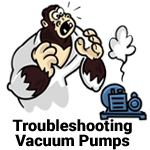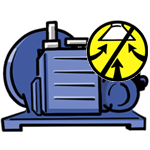
1- The primary cause of insufficient vacuum is due to system leaks. To confirm the vacuum pump is not generating sufficient vacuum, disconnect the pump from the application and test pump with a vacuum gauge. You can purchase a gauge here or contact Chemtech Scientific to evaluate your pump free of charge.
If the vacuum gauge confirms pump achieves good vacuum isolated from the system, you have a system leak(s).
a) Check all connections in system for tightness and tight seal.
b) Hoses and Gaskets - Examine hoses and gaskets visually for cracks. If cracks have developed or if the tubes and gaskets have become brittle, replace them with suitable new ones.
c) Ports open to atmosphere - Check all port valves and confirm they are completely closed, International manufactured valves may close in a different position than domestic manufactured valves. Please consult product literature or manufacturer to assure correct position of vales open or closed.
d) Leak test application appliance. Leak testing application appliance may be performed with soapy water and pressure or acetone leak testing under vacuum. A vacuum gauge will be need for these tests. Contact Us for a laboratory visit or detailed leak testing support.
2- If the gauge pressure reading from a gauge sealed tightly to the pump inlet is above 1 Torr, the pump will require service.
3- If the pump pressure reading is below 1 Torr, a fresh oil change may resolve the problem. The most common cause of a loss in efficiency in a mechanical pump is contamination of oil. It is caused by condensation of vapors and by foreign particles. The undesirable condensate emulsifies with the oil which is re-circulated and subject to re-evaporation during the normal cycle of pump activity, thus reducing the ultimate vacuum attainable. Some foreign particles and vapors may form a sludge with the oil, impair sealing and lubrication and cause eventual seizure.
4- Periodic oil changes are necessary to maintain efficient operation of the system. The required frequency of changes will vary with the particular system. Experiences with the process will help you determine the normal period of operation before an oil change is required.
5- A two stage oil sealed pump should be capable of achieving 10 microns ultimate pressure with gas ballast closed. A single stage pump should obtain 100 microns ultimate pressure.
6- If your problem cannot be resolved using the above troubleshooting steps, contact us for more troubleshooting assistance.



